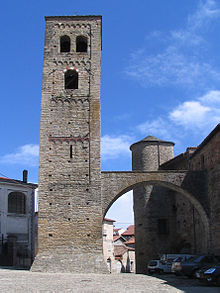Monastero Bormida
| Monastero Bormida | ||
|---|---|---|

|
|
|
| Country | Italy | |
| region | Piedmont | |
| province | Asti (AT) | |
| Coordinates | 44 ° 39 ' N , 8 ° 20' E | |
| height | 191 m slm | |
| surface | 14 km² | |
| Residents | 912 (Dec. 31, 2019) | |
| Population density | 65 inhabitants / km² | |
| Post Code | 14058 | |
| prefix | 0144 | |
| ISTAT number | 005068 | |
| Popular name | Monasteresi | |
| Patron saint | Julia of Corsica | |
| Website | Monastero Bormida | |
Monastero Bormida (in Piedmontese Monasté an Bormia ) is a municipality with 912 inhabitants (as of December 31, 2019) in the Italian province of Asti (AT), Piedmont region .
geography
Monastero Bormida is located on the lower reaches of the Bórmida di Millésimo between the landscapes of the Langhe and Monferrato .
The neighboring municipalities are Bistagno , Bubbio , Cassinasco , Denice , Loazzolo , Ponti , Roccaverano and Sessame .
history
Around the year 1050, Aleramo, the Marquis of Monferrato, called Benedictine monks from the Fruttuaria Abbey in San Benigno Canavese to the Bormida Valley to reclaim the landscape after the devastation by the Saracens . Possibly the monks settled in a place where an older monastery and an ancient settlement had already existed. The monastery (ital. Monasterio ) gave the village its name. In 1393 the monastery was dissolved and the monks moved to the monastery of San Bartolomeo in Azzano d'Asti .
The noble family del Carretto took over the monastery buildings and converted them into a castle. In 1484 Sixtus IV claimed the castle and village for his family, the della Rovere , who kept the castle until the 19th century.
Population development

politics
Ambrogio Spiota has been mayor of the municipality since May 27, 2013.
Attractions
The fact that the castle of Monastero Bormida was the only one in the province of Asti that was not built on a hill goes back to history. The building was built in the 11th century as a monastery on the banks of the Bormida. The 27 meter high, free-standing north tower is still preserved from the church of this time, which is connected to the castle via a round arch that marks the church central nave. The expansion into a representative castle and the demolition of the church began in 1394. The complex was redesigned in both the Renaissance and Baroque periods . Ceiling paintings in the interior testify to this. Today the castle serves as a town hall, among other things.
Adjacent to the castle, a Romanesque arch bridge from the 12th century, with a small chapel in the middle, spans the river. After the catastrophic flooding in 1994, it was completely renewed.
Culinary specialties
In Monastero Bormida, vines are grown for the Dolcetto d'Asti , a red wine with DOC status. The berries of the Pinot Noir and / or Chardonnay grape varieties can be used to make Alta Langa sparkling wine . The Muscat grape for the Asti Spumante , a sweet DOCG sparkling wine with a low alcohol content, and for the still wine Moscato d'Asti is also grown here. The lovely sparkling wine Brachetto d'Acqui is made from the Brachetto grape variety . In Monastero Bormida, vines of the Barbera variety are also grown for the Barbera d'Asti , a red wine with DOCG status, and the Barbera del Monferrato .
proof
- ↑ Statistiche demografiche ISTAT. Monthly population statistics of the Istituto Nazionale di Statistica , as of December 31 of 2019.
literature
- Heinz Schomann : Reclam's Art Guide Italy Volume 1,2. Stuttgart 1982, ISBN 3-15-010305-3
- Beccaria, Grimaldi, Pregliasco (eds.): Piedmont - Langhe and Roero, hills of toil and festivals. Omega Edizioni, Turin 1998, ISBN 88-7241-321-4
Web links
- Page of the municipality (Italian)
- Information at comuni-italiani.it (Italian)




